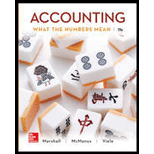
Concept Introduction:
Stock split
In a stock split, company issues additional shares of stock to their existing shareholders to infuse liquidity. When a company wants to lower its market price of its stock in order to make it more enticing to potential investors, they often spit their stock. Although the number of shares outstanding increase but the market capitalization of the company remains the same
Requirement 1:
Shares of common stock owned after stock split
Concept Introduction:
Stock split In a stock split, company issues additional shares of stock to their existing shareholders to infuse liquidity. When a company wants to lower its market price of its stock in order to make it more enticing to potential investors, they often spit their stock. Although the number of shares outstanding increase but the market capitalization of the company remains the same
Requirement 2:
Effect on Market price per share of stock after stock split
Concept Introduction:
Stock split In a stock split, company issues additional shares of stock to their existing shareholders to infuse liquidity. When a company wants to lower its market price of its stock in order to make it more enticing to potential investors, they often spit their stock. Although the number of shares outstanding increase but the market capitalization of the company remains the same
Requirement 3:
Effect on Par value per share of stock after stock split
Want to see the full answer?
Check out a sample textbook solution
Chapter 8 Solutions
Accounting: What the Numbers Mean
- Direct materials:3824, Direct labor:94arrow_forwardHenderson Manufacturing produces wooden furniture. It takes 3.5 hours of direct labor to produce a single chair. Henderson's standard labor cost is $18 per hour. During September, Henderson produced 9,800 units and used 35,600 hours of direct labor at a total cost of $623,000. What is Henderson's labor efficiency variance for September?arrow_forwardSullivan Industries' output for the current period was assigned a $420,000 standard direct materials cost. The direct materials variances included a $32,000 unfavorable price variance and a $18,000 favorable quantity variance. What is the actual total direct materials cost for the current period?arrow_forward
- Idris Sound Systems purchased a one-year insurance policy in February 2023 for $60,000. The insurance coverage is effective from April 2023 through March 2024. If the company neglects to make the proper year-end adjustment for the expired insurance as of December 31, 2023:arrow_forwardfinancial accounting questionarrow_forwardPlease explain the correct approach for solving this general accounting question.arrow_forward
- Satish's vacation home was destroyed by a hurricane. She had purchased the home 30 months ago for $925,000. She received $1,175,000 from her insurance company to replace the home. If she fails to rebuild the home or acquire a replacement home in the required time, how much gain must she recognize on this conversion? A. $250,000 B. $180,000 C. $125,000 D. $0 E. None of the above ??arrow_forwardWhat will be the ending retained Earnings balance ?arrow_forwardI want to this question answer for General accounting question not need ai solutionarrow_forward

 AccountingAccountingISBN:9781337272094Author:WARREN, Carl S., Reeve, James M., Duchac, Jonathan E.Publisher:Cengage Learning,
AccountingAccountingISBN:9781337272094Author:WARREN, Carl S., Reeve, James M., Duchac, Jonathan E.Publisher:Cengage Learning, Accounting Information SystemsAccountingISBN:9781337619202Author:Hall, James A.Publisher:Cengage Learning,
Accounting Information SystemsAccountingISBN:9781337619202Author:Hall, James A.Publisher:Cengage Learning, Horngren's Cost Accounting: A Managerial Emphasis...AccountingISBN:9780134475585Author:Srikant M. Datar, Madhav V. RajanPublisher:PEARSON
Horngren's Cost Accounting: A Managerial Emphasis...AccountingISBN:9780134475585Author:Srikant M. Datar, Madhav V. RajanPublisher:PEARSON Intermediate AccountingAccountingISBN:9781259722660Author:J. David Spiceland, Mark W. Nelson, Wayne M ThomasPublisher:McGraw-Hill Education
Intermediate AccountingAccountingISBN:9781259722660Author:J. David Spiceland, Mark W. Nelson, Wayne M ThomasPublisher:McGraw-Hill Education Financial and Managerial AccountingAccountingISBN:9781259726705Author:John J Wild, Ken W. Shaw, Barbara Chiappetta Fundamental Accounting PrinciplesPublisher:McGraw-Hill Education
Financial and Managerial AccountingAccountingISBN:9781259726705Author:John J Wild, Ken W. Shaw, Barbara Chiappetta Fundamental Accounting PrinciplesPublisher:McGraw-Hill Education





